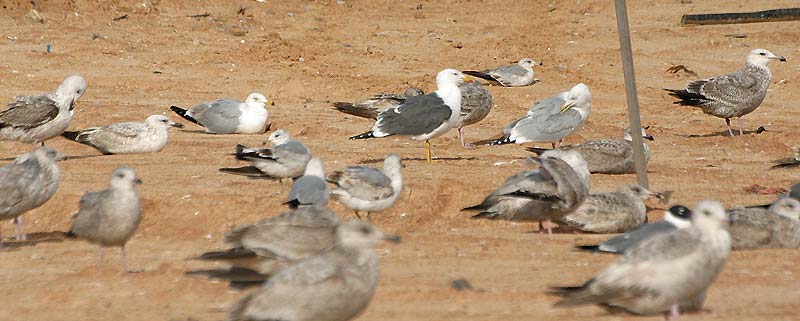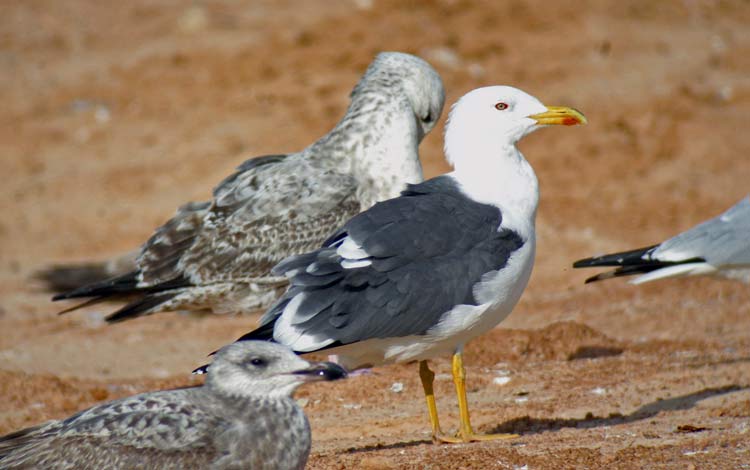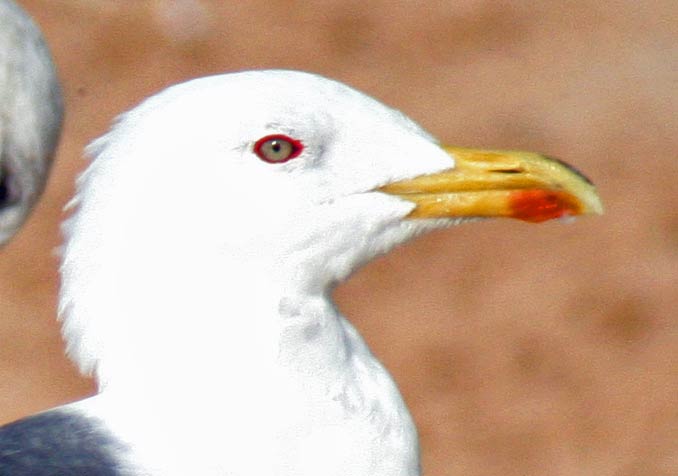
This adult LBBG-type gull was photographed March 25, 2007 in the Coastal Plain near Houston, Texas; It has a number of features associated with heuglini:-
1) Size: it is very large for an LBBG-type; at least a large as an average AMHE, and possibly slightly larger. Using data from Olsen and Larsson's "Gulls of North America, Europe and Asia" the mean weight of AMHE (both sexes) c. 1,100 grams (range 600 - 1,560), while the mean for heuglini is similar at c. 1,060 grams (range (745 - 1,360); the maximum for all forms of LBBG is 1,100 grams .
2) Head shape: a gentle "domed" crown with convex shape between the eye and the bill.
3) Bill shape: shortish and thick-based is most unusual for LBBG forms (and also for male heuglini, so this could be a large female?). Note that in the first two close images I think the head angle (slightly away) is exaggerating the thickness - I've added a third one that gives a different "feel" for the bill shape.
4) Eye speckled with dark such that overall tone of eye is slightly dusky (a large majority of LBBG forms have extremely pale whitish-cream eyes).
5) Outer upper wing coverts: despite no other signs of immaturity the greater and median primary coverts have blackish lines along the outer edge- a typical feature of fully-adult heuglini, but it is now known that some fully-adult LBBGs can have black on the primary coverts - yet birds with the black strongest on the outer edge of each covert feather - as on this individual - are quite rare (typically on LBBG there is a soft blackish wash that uniformly extends to the shaft, plus there is normally a thin solid black patch subterminally along the shaft on the outer 2 or 3 coverts).
6) Wing pattern: note the black extending to P4; only one mirror, on P10 (on a bird that must be a male, based on size), with obvious black subterminal band before the apical spot; thin but obvious white basal crescent to the subterminal black marks on P5 - P7; P7 with black on outer web extending virtually to the tip of its greater primary covert; large white tips to P1 - P4; rather thick white trailing edge to secondaries.
7) Wing tip: fresh-looking white apical tips plus clustering of tips P8 - P10 suggest that the primary molt may just be completing - typical for heuglini in late March but exceptional at best for graellsii/intermedius.
Migration dynamics:
For Houston, the nearest known significant breeding population of LBBG-types is southwest Iceland (the colony on west-central Greenland numbers just a handful of pairs) - this is c. 3,850 miles away. The nearest breeding heuglini (on the northwest corner of the Taimyr Peninsula) is c. 4,975 miles from Houston - a little more than 1,100 miles futher away... but note that the vector for such a route is roughly 180 degrees opposite the typical migration route undertaken by these heuglini - and good numbers of them normally winter from the mouth of the Red Sea around the Horn of Africa quite some distance. These more-distant wintering areas are more than 5,000 miles from the center of heuglini breeding range. Thus if heuglini are like many other Siberian breeders in that a very small percentage of the population "reverse-migrates" in the opposite direction to normal, then a small number would find themselves flying down the center of North America until they reach open coast within their normal latitudinal wintering range (the upper Texas coast is about the same latitude as Eilat, southernmost Israel), less than 5,000 miles away.
:



new third close image:

